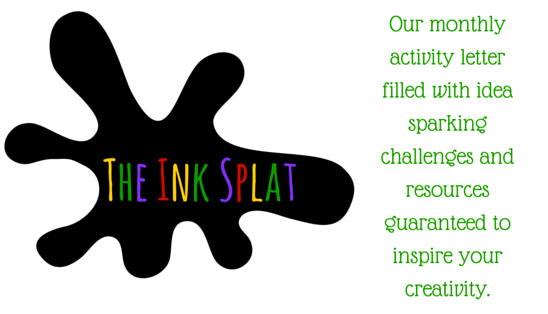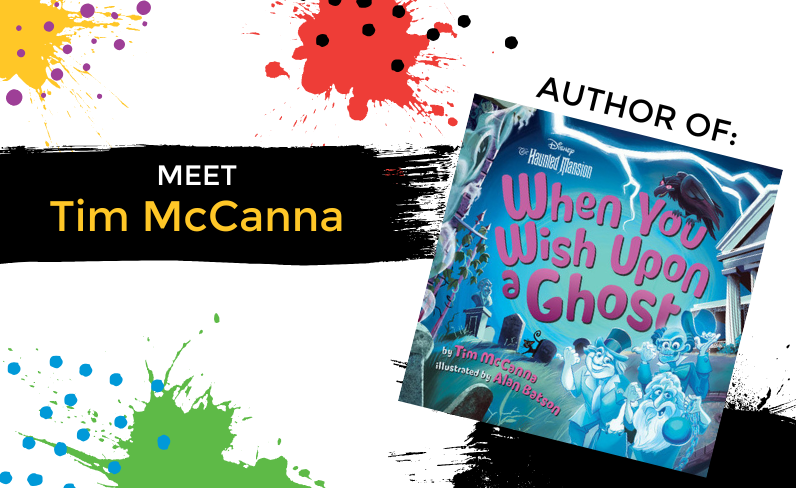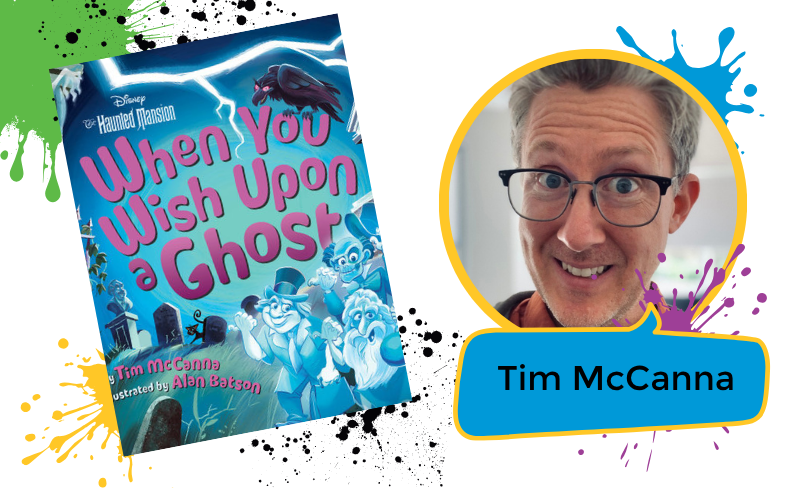Hello Inklings!
This month’s Ink Splat Author Interview features Tim McCanna.
In our interview, Tim shares about his new book, When You Wish Upon a Ghost: Disney’s The Haunted Mansion. He offers tips for using extraordinary places to spark character and story ideas, and gives us a peek into how the creative process presents opportunities to solve puzzles and even to create experiences that feel like theatrical performances.
You can learn more about Tim and his books here: timmccannabooks.com

Writing Challenge
Story Spotting
In his interview, Tim shares how he used the Haunted Mansion’s intriguing details to spark a story.
Try this: go somewhere with a notebook and pencil. Look around for a possible character. Maybe you’ll spot an animal character, like Tim’s raven. Or maybe you’ll even choose to turn an object into a character. Why can’t that creaky gate or lantern be filled with personality and stories to tell?
Write a scene featuring your character, and bringing the location to life. Is this place spooky, like the Haunted Mansion? Or maybe it’s sun-soaked or silly. The tone of your setting can affect both what happens in this place, and how it feels to readers. If you want an extra challenge, play with contrasts. Try setting a silly scene in a quiet place. Or a quiet scene in a silly place. Experiment and have fun!
Once you’re finished with your piece, we’d love to see what you wrote! Did you know that as an Inklings member, you can submit your creative writing on our Inkwell app to share with an audience of enthusiastic readers? You can ask for revision feedback on a work in progress, or submit a finished piece and hear back from readers about what they loved.
Join us and share your writing on the Inkwell!

You write a range of books—picture books of all kinds—and you even write and illustrate graphic novels. Tell us what you love most about telling stories and creating books.
Gosh, I love the creative process on multiple levels. Part of it is the puzzle-solving aspect, whether it’s experimenting with language or piecing together a surprising plot. Devising unique, engaging stories is not easy! Sometimes writing can be slow and frustrating, but when a story comes together, it’s really amazing and satisfying. The end result is a picture book that not only has visuals, but also a read-aloud aspect that feels like a theatrical performance!
Your book, When You Wish Upon a Ghost, just came out! Congratulations!! Tell us the story of how you ended up writing for Disney, and especially how you ended up writing a picture book set in Disneyland’s Haunted Mansion.
Thanks! Five years ago I attended an online seminar hosted by a Disney editor who discussed “extension stories.” Those are books that expand the universe of an existing intellectual property, like Cars or The Little Mermaid. After the seminar, I submitted a sample story to Disney, but nothing happened for over a year. Then one day I got an email offering an opportunity to work on an extension story assignment! Those jobs are quick turnarounds, but really fun. I’ve done five so far, including Stitch’s Valentine and How Far You’ll Go. When You Wish Upon a Ghost was a unique challenge. Disney provided the title and the location of the Haunted Mansion, and I got to come up with an original story and write it!
Tell us about crafting this story. How did you use the setting to spark characters and a storyline? Did anything surprise you along the way?
The Disney editor I worked with suggested that the story might explore the mansion through the eyes of a raven. Fans of the Haunted Mansion know that there is a red-eyed raven that appears in various rooms throughout the ride. I pitched a few story options and we ultimately went with one where Raven is tasked to assemble the ghosts for a party, but he’s not invited. Since I love writing in rhyme, I took inspiration from Edgar Allen Poe’s poem, The Raven, and put my own creative voice into the storytelling style. I also did a ton of research on the history of the Haunted Mansion and all the spooky inhabitants—and was surprised to discover there is a deep fanbase who know every little detail of the Haunted Mansion’s lore. I felt very responsible to capture the spirit just right!
You started your career writing a range of picture books. Some are more poetic, like Watersong, and others are more character driven, like the Bitty Bot books. How do you think about the picture book genre in general? Why do you think there is so much creative range in books that blend visuals and short texts?
Well, I think there’s so much creative range in picture books because the target audience is so broad and yet so unique. Young children have such vivid imaginations and are willing to accept all kinds of stories—as long as they are told well. Kids are such a delightful audience because they are so willing and able to learn and discover and invest in a character’s story. And, there’s also so much creative range in picture books because we have these big character archetypes in children’s literature like robots, dogs, pirates, dinosaurs, bugs, and so many more. These larger-than-life characters lend themselves to all kinds of style and interpretation, which means there will always be new stories told in new ways by the next generation of writers.
This month at Society of Young Inklings, we’re talking about pacing. How do you think about pacing in your writing and in your illustration? What strategies do you use to speed up or slow down the pace of your storytelling?
That’s very cool. I think pacing is directly connected to a main character’s action or inaction. And inaction isn’t always a bad thing. The pace of your page turns and story development increases when your character has a goal with stakes that they are actively pursuing. Maybe they are facing all sorts of obstacles and conflicts along the way. Maybe there’s a ticking clock that adds extra tension. But stories need peaks and valleys. You can slow down the pace when a character faces a roadblock, or needs to rest and think, or maybe they meet a new character. And then you can ramp up the pace by upping the stakes even more and pushing your character into forward momentum again. As a writer, I also think about controlling pace with styles of language. If you use shorter, more rhythmic, even staccato sentences, your information moves more quickly and feels like a faster pace. If you use longer, more rolling sentences that maybe focus on description or dialogue, that can slow down the pace.
Check out When You Wish Upon a Ghost and all of our recent Ink Splat authors’ works at our Bookshop.org Store.



